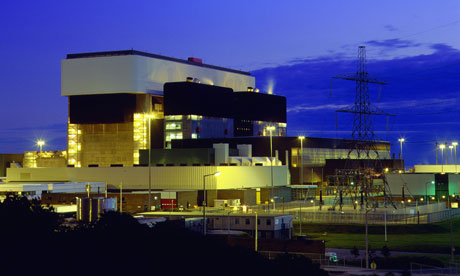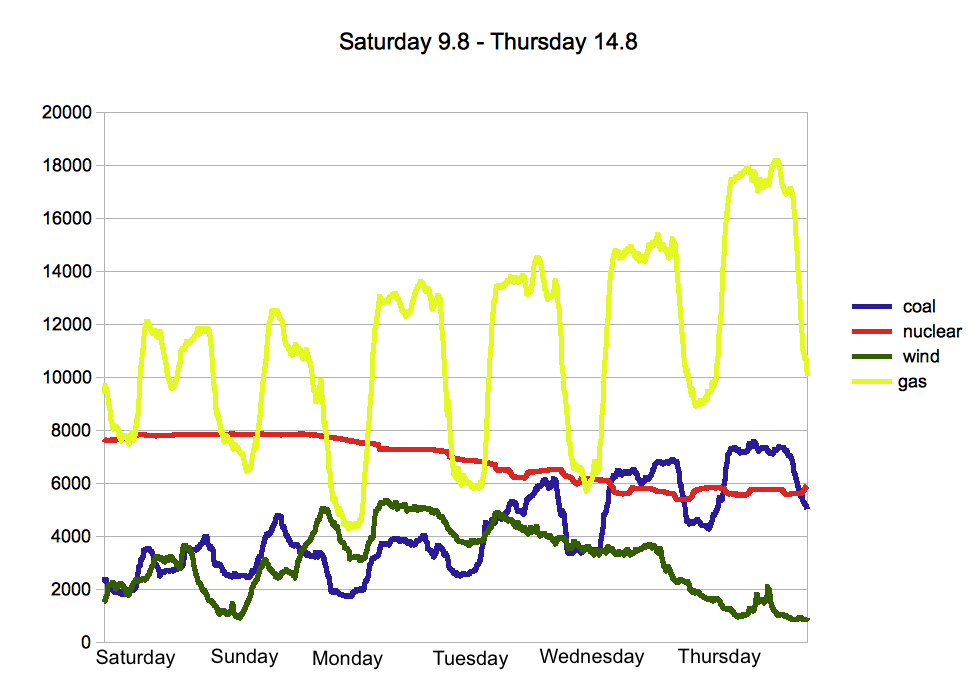
This is a re-post from PassiiviIdentiteetti, written by Jani-Petri Martikainen.
Answer: mainly by increasing the use of coal in power production.

In the second week of August power company EDF decided to shutdown their reactors in Heysham and Hartlepool. This was a precautionary measure after finding a defect in the boiler of Heysham unit 1. In total 4 reactors that can produce up to 2.6 GigaWatts (GW) of electricity were turned off. On the week they were turned off, the UK used an average of 30 GW.
Some were quick to declare that wind power came to the rescue when nuclear power was proven unreliable (for example Ari Phillips in Thinkprogress, Greenpeace, Giles Parkinson in reneweconomy.com.au...). More recently Justin McKeating from Greenpeace repeated the claim: "...we see a reversal of the view that renewables need to be supported by nuclear power. Although nuclear and wind power do not have the same generation characteristics, nuclear reactors now needing to lean on renewables means the nuclear industry has a big problem." Given that the claim appears unlikely on meteorological grounds and no evidence for it was provided, I felt a more careful scrutiny was called for.
So, did wind power replace missing nuclear capacity? Short answer is, no it did not. Missing nuclear generation was mostly replaced by increasing use of coal.
In Figure 1 I show the output of relevant power sources in the UK between Saturday 8th August and Thursday 14th August. EDF reactors were ramped down during this period and this can be clearly seen in the figure. Equally clear is that when nuclear output was declining, wind power output was declining even more steeply. So rather than coming to the rescue, wind power was unfortunately galloping away when the action started. The reduction in the amount of wind and nuclear power was mirrored by a clear increase in gas and coal power. Contrary to earlier claims, low carbon sources were replaced by fossil fuels.

Fig 1: UK power production during the reactor shutdowns.
This quick check does provide the answer to our specific question, but with the data available we can learn more. In the following table I show the average power levels for the most relevant quantities shortly before and after the shutdowns. The most pronounced changes were in the amounts of power derived from fossil fuels, nuclear power, and wind power. There was also some increase in hydropower generation. Weeks following the shutdowns were in fact more windy (not unusually so) than weeks prior to shutdowns and power generation from fossil fuels has increased slightly. However, as the earlier figure makes clear, to understand which power source is replacing which one must look deeper than averages.
| Period 27th Jul-9th Aug [GW] | 14th Aug-28th Aug [GW] | Change [GW] | |
| Demand | 30.4 | 30.3 | -0.1 |
| Nuclear | 7.9 | 6.0 | -1.9 |
| Wind | 1.3 | 2.3 | +1.0 |
| Gas | 12.4 | 11.5 | -0.9 |
| Coal | 4.6 | 6.1 | +1.5 |
| Interconnects | 2.6 | 2.6 | 0 |
To get a clearer insight as to how different power sources are connected in the UK, we can inspect the data for the year 2013. As an example, Figure 2 shows the scatter plot of wind vs. gas for one month period in 2013 together with a least square fitted line. When wind generation is high, gas generation drops by almost the same amount as wind power increased by. This fits with the idea that electricity companies use wind power to replace gas. The color indicates power demand at that moment. As demand goes up, the colour of the dots on the graph goes redder. This correlates with high gas use. In other words, when demand goes up, power stations burn more gas. There is no such correlation with wind power on short timescales: it's windier when it wants to be and that doesn't necessarily correlate with when we want to use the most power.

Fig 2: Scatter plot of the wind power generation vs. generation with natural gas for a month around April 2013. Color indicates power demand at that moment. Note: axes are unevenly spaced along y-axis relative to x-axis. Each dot represents a 5 minute period.
In the UK, wind power is attractive because the windiest months are in the dark and cool winter, when electricity demand is highest. However, the hour-to-hour or day-to-day windiness doesn't line up quite so well with UK power demand. The weather does what it wants. Although the weeks after the nuclear reactors went off saw a slight increase in total wind power from the weeks before, it didn't replace the lost nuclear power. Sadly, more coal was burnt to keep the lights on. If this happens again on calm, windless days, the UK would have to burn even more fossil fuels.
UK production and demand data suggest common sense relationships. Wind power acts mainly together with gas while missing nuclear reactors were (sadly) mostly replaced by burning more coal. In the long run it might be technically possible to do without coal. This could be done by using electricity storage like batteries or trading between countries, so that times or places where it's windy can export electricity to times or places when it's not. Changing power demand to match supply, so that power-hungry appliances and industries turn on when it's windy could also help. However, it will be some considerable time before wind power has the capacity to take the place of fossil fuels to meet our power needs.
Posted by Guest Author on Tuesday, 30 September, 2014
 |
The Skeptical Science website by Skeptical Science is licensed under a Creative Commons Attribution 3.0 Unported License. |